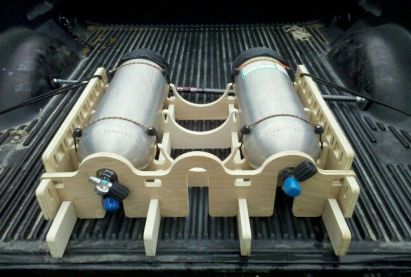How To Take Good Care Of Your Dive Cylinder
Care Your Dive Cylinder
Although scuba cylinders have been designed to exceed stringent performance and safety standards, it's up to you to ensure that your cylinder is always kept in peak condition by carefully following these recommendations for continued care and maintenance.
REMEMBER!
By taking care of your cylinder you'll be rewarded with many years of safe, trouble-free service. Protect it from damage and never abuse or modify it. Neglecting the cylinder could result in irreversible deterioration and a potential threat to personal safety. Wash your cylinder in fresh water and dry after each use.
Before Filling
For New Scuba Cylinders
Ensure that your cylinder is fitted with a compatible valve and associated components. Putting the wrong valve on a scuba tank can result in a very explosive and potentially deadly situation.
When using oxygen-enriched air, oxygen or nitrox mixtures, ensure that the cylinder is fitted with an oxygen or nitrox-compatible valve assembled with an oxygen compatible O-ring and lubricant. If your cylinder is Oxygen Clean then it should be marked as such with an appropriate sticker.
Establish that the filling facility is suitable for providing a controlled oxygen-enriched air-fill, which must be totally free from oil carry-over and loose particulate, such as at The Scuba Doctor.
If there's no assurance that the valve, O-ring and lubricant used is oxygen compatible, or that the filling conditions conform, The Scuba Doctor recommends that you don't fill the cylinder until oxygen suitability is confirmed.
If you choose a standard air-fill only but decide to switch to an oxygen-enrich fill at a later date, remember to ensure that your cylinder is oxygen clean and that your valve and associated accessories are oxygen compatible and clean.
For Continued Use of the Scuba Cylinder
Check that the cylinder is within its re-test period. In Australia, testing is required to be done annually. Cylinders should be stamped with the test centre number plus the month and year they were last tested, e.g. 01 14 (Jan 2014). This example means the cylinder can be filled until the end of January 2015 before having to be tested again.
NEVER fill a cylinder that's outside its re-test period.
Visually examine the cylinder for evidence of damage from previous use or transportation. If in doubt (i.e. the cylinder shows signs of ANY damage) take it to a re-test station, like Scuba Doctor Service and Repairs, for an expert opinion and/or hydro testing.
Determine if the cylinder shows external corrosion from poor storage, particularly after lengthy storage. If corrosion is evident, take the cylinder to a re-test station, like Scuba Doctor Service and Repairs, for an expert opinion and/or hydro-testing.
An appropriate valve (with the correct thread) should be torqued into the cylinder using calibrated torque wrenches with correctly fitting engagement heads. Torquing of valves should be in line with ENISO 13341:1997 for aluminium parallel threads.
Filling Scuba Cylinders
Before you connect the cylinder to the compressor or storage bank ALWAYSverify the rated filling pressure.
NEVER fill the cylinder or allow it to be filled beyond the maximum rated working pressure (WP) shown on the cylinder neck.
If you suspect or hear a hissing sound — stop filling immediately. NEVER fill or use a cylinder that is leaking. The cylinder must be taken to an approved re-test station, like Scuba Doctor Service and Repairs, for a thorough examination. Never try to tighten the valve if leaking around the cylinder neck.
ALWAYS check for leaks after filling and before use by immersing the cylinder into a tank or container of water. Take enough time to thoroughly check for even the smallest escaping bubble!
It is strongly recommended that extreme care is taken to avoid any moisture transfer into your diving cylinder or buoyancy aid during filling. Buoyancy aids should not be filled from a diving cylinder.

Tank Safety Care and handling of high-pressure cylinders Most divers assume their cylinders are safe

 English
English
 Ελληνικά
Ελληνικά Русский
Русский




























 Posted by
Evi Neocleous
Posted by
Evi Neocleous






